- Features
- Create a segment
- Facet Features
- Types of Facets
- Configure Facets
- Field Mapping
- Field Properties
- Real-time Preview
- Instantaneous Publishing
- Ranking Insights
- Clickstream Data
- Boost/Bury
- Sort
- Slot
- Pin
- Filter
- Landing Pages
- Set Banners
- Create a Site Rule
- Managing Field Rules
- Managing Page Rules
- Campaign
- Overall Performance
- Page-Level Reporting
- Zero Result Categories
- Product Reports
Browse Reports
The Reports section summarizes the overall browse performance of your website and allows you to take data-backed decisions to continuously improve conversion on your website. The analytics data collected on your website is aggregated and summarised in the form of reports to enable you to derive insights from the reports. The insights gained from Unbxd reports can be used to create marketing campaigns, configure browse and search, and autosuggest for improving conversions.
The Report section gives you in-depth insights on the visitor interactions, page and product performances. Merchandisers can take quick actions on pages, and fields on the site by referring to the Reports section of the console.
Overall Performance
The overview page gives holistic view of essential performance metrics such as Clicks, Carts, Orders, %Conversion Rate, Top Page Views, Top Clicked Products, and Top Ordered Products, Zero Results Pages for the last 15 days. It helps merchandisers get a complete understanding of the trending queries, products, and the zero-results pages on a quick glance.
You can toggle between two types of graphs:
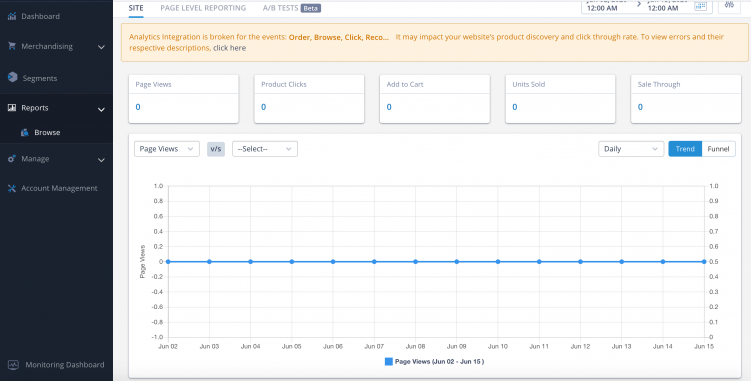
Trend
The trend graph lets you view the performance comparison of any two metrics for the selected time frame. You can choose to view the trends of – page views, carts, orders, and conversions and lets you easily switch between Daily, Weekly and Monthly reports.
Funnel
The funnel graph shows you the conversion funnel of the essential performance metrics data (hits, clicks, carts, orders) for the selected time frame.
Study Correlation Metrics
The browse report allows you to review trends in browse performance over time. You can select and plot any 2 metrics from ‘Page Views’, ‘Clicks’, ‘Carts’ ,’Orders’, ‘Revenue’, ‘% Conversion rate’, ‘%CTR’ and ‘AOV’ to check how the metrics varied over a selected duration.
A product manager or e-commerce Director can use this feature to quickly verify their hypothesis by studying correlation between two parameters. For example, if you have revamped the UI of the product listing page on April 07, 2020. You can plot a chart between Page Views & Clicks for the duration April 01,2020 to April 15,2020. If the new UI is better than the old UI then you can spot a sudden jump in Clicks chart after April 07,2020.
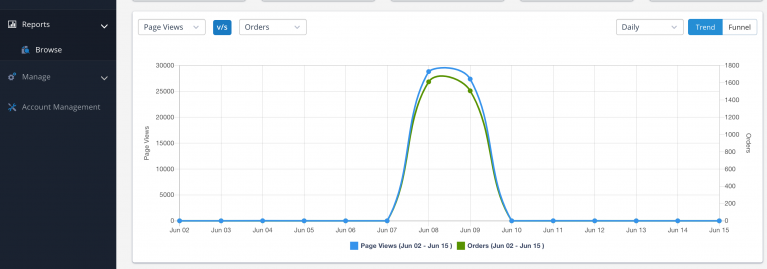
Before and After Comparison
One of the most important factors to apply in this filter is ‘Compare Date Range’. The browse report allows you to plot and compare the trends for two separate time durations. You can enable this option by selecting the “Compare Date Range” checkbox in the date selection menu. ‘Compare Date Range’ allows you to select two different date ranges to generate a report depicting the comparison between those date ranges for the chosen metric.
To compare reports using date range:
- Navigate to Reports > Browse.
- Click the ‘calendar’/ ‘date picker’ icon on the navigation panel that opens up the date range filter and select the ‘Compare Date Range’ checkbox.
- Once selected, you will see two calendar pop-ups which will allow you to choose date ranges on both of them
NOTE: The analytics events generated from your website are aggregated and available for this report immediately.
Selecting other filters
The overall browse performance report provides options to filter data based on Location, Device and Visitor type. These filters can be used to study the performance of browse for a specific segment. These filters allow you to validate hypotheses related to specific device type, visitor type or Geography.
For example, if you have started a promotion for first time users and you want to evaluate if the promotion has led to higher conversions & higher traffic. You can apply a filter for Visitor type=New in the report, and plot conversion rates & traffic for time periods before the promotion and after the promotion launch.
You can generate reports for a particular device, location, or visitor type by navigating to Reports > Browse and clicking the filter icon on the navigation panel near the calendar icon.
|
Attributes |
Description |
Representational Image |
|
Device |
Shoppers may access your site by logging in to either a desktop, mobile, or a tablet. The metrics for each device is calculated separately. You can filter by device and get the report. |
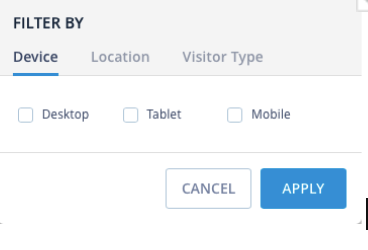 |
|
Location |
Shoppers may login to your site from different geographical regions. Metrics vary a big time with respect to different regions. You can filter by locations and get the particular metrics. |
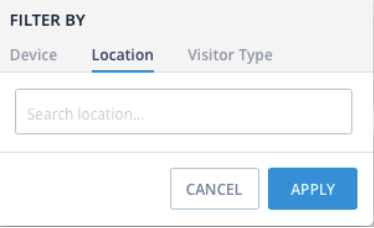 |
|
Visitor Type |
Shoppers are of two types: Either they are the ones who have already logged in once (existing) or who login for the first time (New). You can filter by visitor type and get a report for the type of shoppers. |
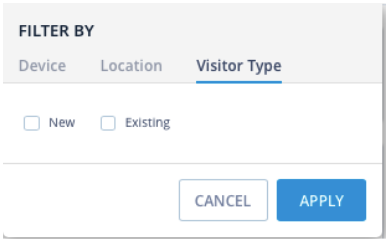 |
Selecting Date & Time for report
Reports are always generated for a defined time range.
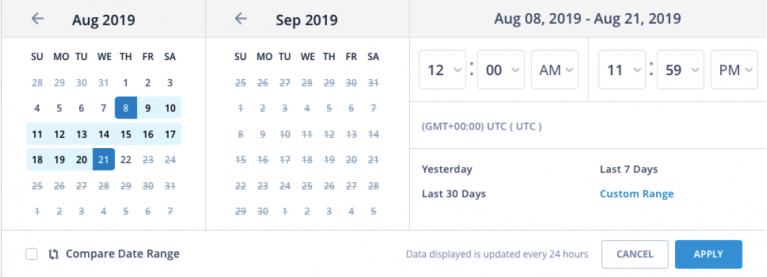
You can apply this filter to generate a report for the selected date and time range:
- Yesterday
- Last 7 days
- Last 30 days, or
- Custom range
Explanation of Metrics
The reports are generated based on various metrics. Understanding these metrics is extremely important in order to extract the maximum output value. All the metrics used in our reports are mentioned below:
|
Metrics |
Description |
|
Page Views |
Number of times shoppers visit a category of pages |
|
Clicks |
Number of times shoppers select a product from the Product Listing Page (PLP) |
|
Carts |
Number of products that are added by the shoppers to their temporary shopping list to place an order then or later |
|
Products Sold |
Number of times shoppers select products from the cart with an intent to buy |
|
Sell Through |
Number of products sold |
|
% Conversions |
% Conversion rate= Number of orders/ Number of hits a product gets Conversion Rate is defined as how many products were ordered out of the page types that were browsed |
|
% Click Through Rate (CTR) |
% CTR= Number of clicks/ Number of hits CTR defines how many times shoppers selected a product after browsing for it |
|
Average Order Value (AOV) |
AOV= Total revenue/ Total number of orders AOV defines average money spent for every order that was placed by a shopper on mobile application or a website |
|
% Sell Through Rate (STR) |
%STR= Number of inventory purchased/Sold to the customer STR defines how many products were sold out to the amount of inventory purchased by the merchandiser |
|
Revenue |
Amount generated for the number of orders placed by the shoppers |
Page-Level Reports
The page level reporting section gives a detailed report of pages based on hits, click through rate, clicks, carts, orders, %conversion, and revenue per browse. Merchandisers can also drill down to performances of each individual page by clicking on it. Doing so can will show you the trends and the funnel report for that particular page. Merchandisers can also view the the details of the popular products for the particular page.
The queries are sorted on hits in ascending order by default, you can however sort on any of the other metrics. A standard date selector interface lets you change the time period for the report.
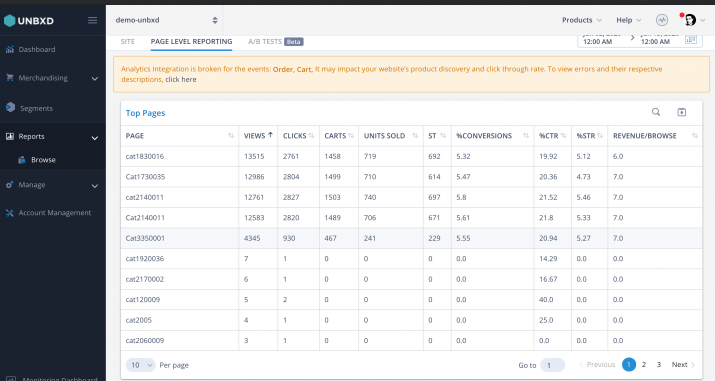
As you can see in the illustration above, the category page cat1800316 was being viewed 13515 times and the products from the same page were bought 719 times. Looking at the ‘Top Pages’, you can infer which category pages are bringing in the highest conversion rate and revenue. As a merchandiser, these insights may help you in boosting high performing pages.
You can also download a page report. To do that click the ‘download’ icon.
Zero Result Categories
Zero results categories display the pages for which no results were displayed for the selected time period.
Some of the most common reasons for zero results along with some fixes is suggested below:

As we can see in the above illustration, there is a category ‘Women Category’ with a click of 1483 times which gave zero results.
Product Reports
The Product report displays the individual metric of the product as to how many times the product was viewed from the category page, added to cart, or ordered.
Top 1000 products provide you a glimpse of the most ordered and viewed products on the website. The product report can help you in:
- Checking if the boosted products are performing well or if the negatively boosted products have received less number of views
- The changes in shoppers preference for products can be compared by checking the top products list for different time frames
- Identifying products with high visibility and low conversions. You can apply a negative boost for such products in order to suppress the ranking for such products.
- Identifying out-of-stock products : Products which are frequently added to cart but not ordered are a good candidate for out of stock products. A high cart drop-off rate for these products may also indicate the some of you competitors might be offering these products at lower prices.
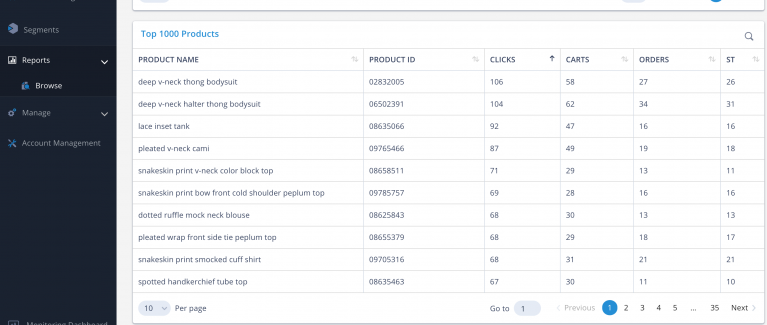
In the above illustration, you can see every product like ‘deep v-neck thong bodysuit’ was added to the cart 58 times, and ordered 27 times.
You can sort the products based on any of the metrics to see the most sold products, most viewed product or the product added to cart maximum number of times. To download a product report, click the download icon on the top-right part of the screen. Field mapping is required to display the ‘Product name’ & ‘Unique ID’ correctly.
- Did this answer your question?
On this Section
- Correlation metrics
- Selecting Filters
- Explanation of Metrics
- Query Level Analysis